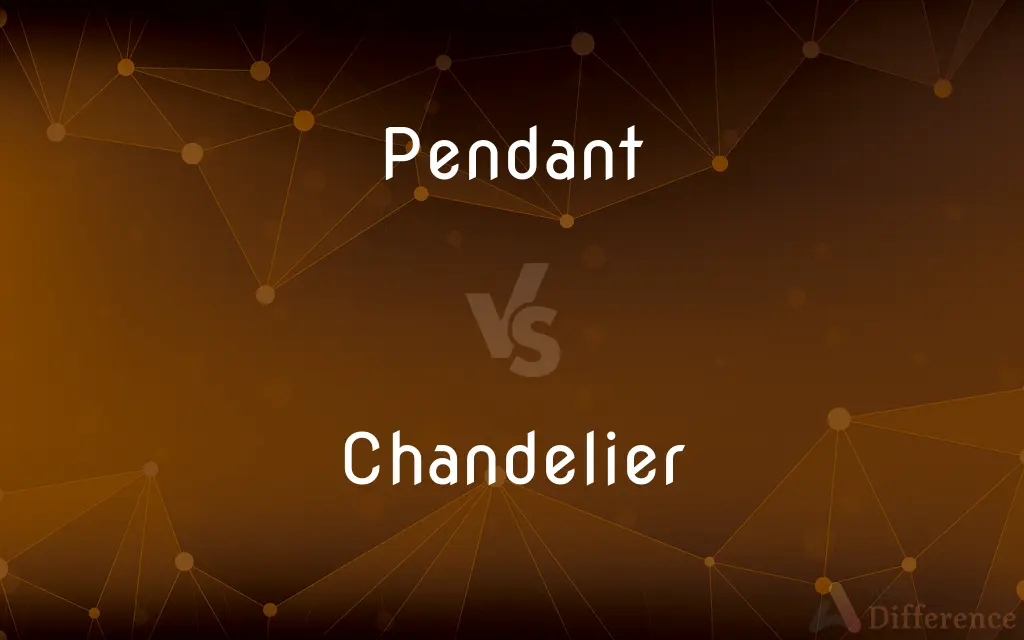Pendant vs. Chandelier — What's the Difference?
By Tayyaba Rehman & Fiza Rafique — Published on March 5, 2024
Pendant lights hang from a single cord, offering focused illumination, ideal for task lighting. Chandeliers feature multiple branches for bulbs, providing broad, decorative lighting.

Difference Between Pendant and Chandelier
Table of Contents
ADVERTISEMENT
Key Differences
Pendant lights are a versatile lighting option that hang from the ceiling on a cord, chain, or metal rod, often used to provide direct lighting over specific areas like kitchen islands, dining tables, or reading nooks. Chandeliers, on the other hand, are more elaborate fixtures with multiple arms or branches, designed to illuminate a larger area with an aesthetic appeal, making them suitable for entryways, grand rooms, or formal dining areas.
The design of pendant lights can range from simple and sleek to intricate, but they generally maintain a minimalistic approach compared to chandeliers. Chandeliers are known for their complexity and decorative elements, often incorporating materials like crystal, glass, or intricate metal work, which contribute to their status as a focal point in a room.
Installation of pendant lights is typically straightforward, requiring a single connection point on the ceiling. This simplicity allows for flexibility in arrangement, such as clustering multiple pendants for a more dramatic effect. Chandeliers, given their size and complexity, may require special ceiling reinforcement and are usually installed as a central lighting feature in a room.
The functionality of pendant lights leans towards task lighting, focusing brightness on a specific surface or area, which makes them highly effective for workspaces or areas requiring concentrated light. Chandeliers distribute light more broadly and are often used in conjunction with a dimmer to adjust the room's ambiance, serving both functional and decorative purposes.
From a cost perspective, pendant lights can be a more economical option due to their simpler design and the fact that they often require fewer materials. Chandeliers, with their detailed craftsmanship and multiple light sources, tend to be more of an investment, reflecting their role as a statement piece within an interior design scheme.
ADVERTISEMENT
Comparison Chart
Design
Single light source hanging from a cord
Multiple branches for bulbs
Illumination Type
Direct, focused lighting
Broad, ambient lighting
Installation
Simple, may hang in clusters
More complex, often a central feature
Functionality
Ideal for task lighting
Decorative, enhances room ambiance
Cost
Generally more economical
Typically more expensive
Compare with Definitions
Pendant
Single fixture hanging from the ceiling.
A pendant light hung over the kitchen island, providing ample light for cooking.
Chandelier
Elaborate fixture with multiple arms.
The crystal chandelier in the ballroom added a touch of elegance to the event.
Pendant
Used for task lighting.
She installed a row of pendant lights above her work desk for better visibility.
Chandelier
Reflects style and sophistication.
A contemporary chandelier in the entryway set the tone for the home's modern aesthetic.
Pendant
Can be simple or decorative.
The designer chose a sleek, modern pendant light to complement the minimalist decor.
Chandelier
Serves as a room's focal point.
A rustic chandelier became the centerpiece of the renovated farmhouse living room.
Pendant
Often adjustable in height.
The pendant lights were adjusted to hang lower over the dining table for intimate dinners.
Chandelier
Often used in formal settings.
They chose a classic chandelier to highlight the grandeur of the formal dining room.
Pendant
Versatile in application.
Pendant lights in the foyer created a welcoming atmosphere without overwhelming the space.
Chandelier
Can provide dimmable ambient lighting.
The chandelier's dimmer function allowed for mood lighting during dinner parties.
Pendant
Something suspended from something else, especially an ornament or piece of jewelry attached to a necklace or bracelet.
Chandelier
A branched, decorative lighting fixture that holds a number of bulbs or candles and is suspended from a ceiling.
Pendant
A sculptured ornament suspended from a vaulted Gothic roof or ceiling.
Chandelier
A branched, often ornate, lighting fixture suspended from the ceiling
Pendant
Hanging down; dangling; suspended.
Chandelier
A portable frame used to support temporary wooden fences.
Pendant
A lamp hanging from the roof.
Chandelier
A candlestick, lamp, stand, gas fixture, or the like, having several branches; esp., one hanging from the ceiling.
Pendant
An ornament of wood or of stone hanging downwards from a roof.
Pendant
A hanging ornament on roofs, ceilings, etc., much used in the later styles of Gothic architecture, where it is of stone, and an important part of the construction. There are imitations in plaster and wood, which are mere decorative features.
Common Curiosities
Where are pendant lights most commonly used?
Pendant lights are versatile and can be used in kitchens, dining areas, reading nooks, or over bars and islands for direct lighting.
Where should a chandelier be placed in a home?
Chandeliers are best suited for entryways, grand rooms, formal dining areas, or any space where a decorative focal point is desired.
What is a chandelier?
An elaborate, decorative lighting fixture with multiple arms or branches, designed to illuminate a large area and serve as a decorative element.
Can pendant lights be used as a main light source?
While pendant lights provide focused lighting, multiple pendants or a combination with other lighting types can serve as a room's main light source.
Is it easy to install a pendant light or chandelier by yourself?
Pendant lights are generally easier to install than chandeliers, which may require professional installation due to their weight and complexity.
What is a pendant light?
A light fixture that hangs from the ceiling on a cord, chain, or metal rod, often used for focused, task lighting.
How do you clean pendant lights and chandeliers?
Both should be dusted regularly, with glass or crystal elements cleaned with a suitable cleaner. Chandeliers may require more detailed cleaning due to their complexity.
How do I choose between a pendant light and a chandelier?
Consider the space's function, size, and decor style. Pendant lights are suited for specific tasks and smaller spaces, while chandeliers make a statement in larger, more formal areas.
Can LED bulbs be used in these fixtures?
Yes, both pendant lights and chandeliers can accommodate LED bulbs, offering energy efficiency and long-lasting light.
What materials are pendant lights and chandeliers made from?
Both can be made from a wide range of materials, including metal, glass, crystal, wood, and fabric, depending on the design.
How do I know the right size chandelier for my room?
A general rule is to add the room's length and width in feet, which equals the chandelier's diameter in inches, ensuring proportional sizing.
Are chandeliers outdated?
No, chandeliers continue to evolve in design, ranging from traditional to modern styles, making them timeless pieces for adding elegance to spaces.
Do pendant lights offer different styles of lighting?
Yes, pendant lights can provide downlighting for tasks, uplighting for ambient effect, or a combination for versatile illumination.
Can chandeliers be energy efficient?
With the use of LED bulbs and dimmer switches, chandeliers can be both energy-efficient and adaptable to varying lighting needs.
Are there outdoor pendant lights and chandeliers?
Yes, there are outdoor-rated pendant lights and chandeliers designed to withstand the elements, enhancing outdoor living spaces.
Share Your Discovery

Previous Comparison
Overlapping Social Differences vs. Cross-Cutting Social Differences
Next Comparison
Hungry Jack’s vs. Burger KingAuthor Spotlight
Written by
Tayyaba RehmanTayyaba Rehman is a distinguished writer, currently serving as a primary contributor to askdifference.com. As a researcher in semantics and etymology, Tayyaba's passion for the complexity of languages and their distinctions has found a perfect home on the platform. Tayyaba delves into the intricacies of language, distinguishing between commonly confused words and phrases, thereby providing clarity for readers worldwide.
Co-written by
Fiza RafiqueFiza Rafique is a skilled content writer at AskDifference.com, where she meticulously refines and enhances written pieces. Drawing from her vast editorial expertise, Fiza ensures clarity, accuracy, and precision in every article. Passionate about language, she continually seeks to elevate the quality of content for readers worldwide.
















































